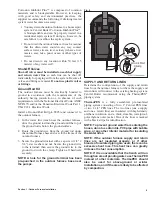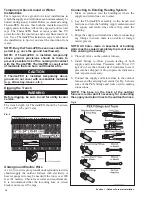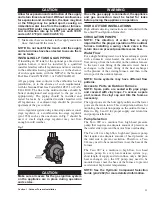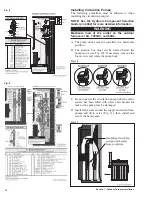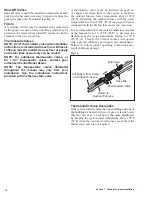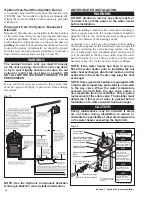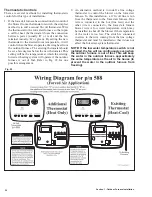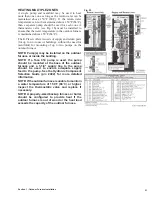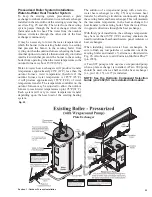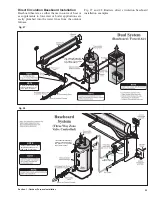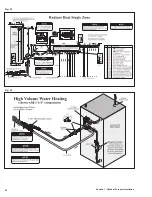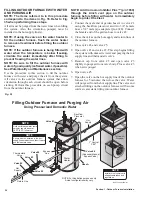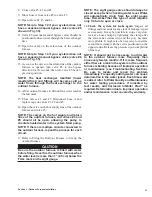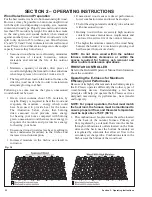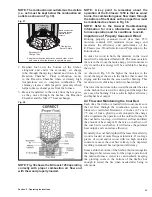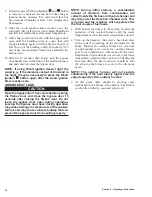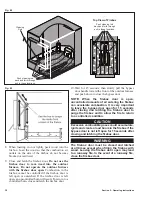
23
Section 1 - Outdoor Furnace Installation
Pressurized Boiler System Installations
Water-to-Water Heat Transfer System
To keep the existing system pressurized, a plate
exchanger or tube & shell water-to-water heat exchanger
installed in the return line of the existing system may be
used (see Fig. 25 and 26). The water from the existing
system passes through the heat exchanger when the
thermostat calls for heat. The water from the outdoor
furnace circulates through the other side of the heat
exchanger continuously.
It may be necessary to lower the water temperature at
which the burner in the existing boiler starts to a setting
that prevents the burner in the existing boiler from
cycling on when the outdoor furnace is heating the home.
Another option is to install a thermostatically controlled
interlock switch that prevents the burner in the existing
boiler from operating when the water temperature in the
outdoor furnace is above 150˚F (66˚C).
Water-to-water heat exchangers will produce transfer
temperatures approximately 20ºF (11˚C) less than the
outdoor furnace water temperature; therefore if the
outdoor furnace water temperature is 185°F (85˚C),
it will produce approximately 165°F (74˚C) of water
temperature transfer. The temperature controller on the
outdoor furnace may be adjusted to allow the outdoor
furnace to reach water temperatures up to 195ºF (91˚C).
Each system will vary in water temperature transfer
depending upon the heat load of the existing heating
system.
The addition of a wraparound pump with a water-to-
water heat exchanger (see Fig. 25) may increase heat
transfer by allowing circulation continuously through
the existing boiler and heat exchanger. This will maintain
the maximum temperature in the heat exchanger for
heat transfer to the existing boiler. Note the water flows
in opposite directions through the heat exchanger.
With this type of installation, the exchange temperature
may be more than 165°F (74˚C) and may eliminate the
need for additional baseboard heaters, panel radiators or
heat exchangers.
When installing water-to-water heat exchangers, be
sure to flush any rust particles or sediments out of the
existing boiler and install a Y-strainer as illustrated in
Fig. 25. Also be sure to add Corrosion Inhibitor Plus™
(p/n 1650).
A Taco 007 pump can be used as a wraparound pump
when a plate exchanger is installed. A Taco 009 pump
should be used when a shell and tube heat exchanger
(i.e., p/n 148, 151 or 177) is installed.
NOTE: See the Hydronic Component Selection
Guide (p/n 2482) for more detailed information.
Plate Exchanger
Fig. 25
Summary of Contents for e-Classic 1450 IR
Page 17: ...15 Section 1 Outdoor Furnace Installation...
Page 29: ...27 Section 1 Outdoor Furnace Installation Fig 30 Fig 31...
Page 30: ...28 Section 1 Outdoor Furnace Installation Fig 32 Fig 33...
Page 66: ...64 E CLASSIC 1450 WIRING DIAGRAM Section 6 General Information...
Page 67: ...65 Section 6 General Information E CLASSIC 1450 WIRING DIAGRAM OPTIONAL POWER IGNITION...
Page 69: ...67 NOTES...
Page 70: ...68 NOTES...
Page 71: ...69 NOTES...

